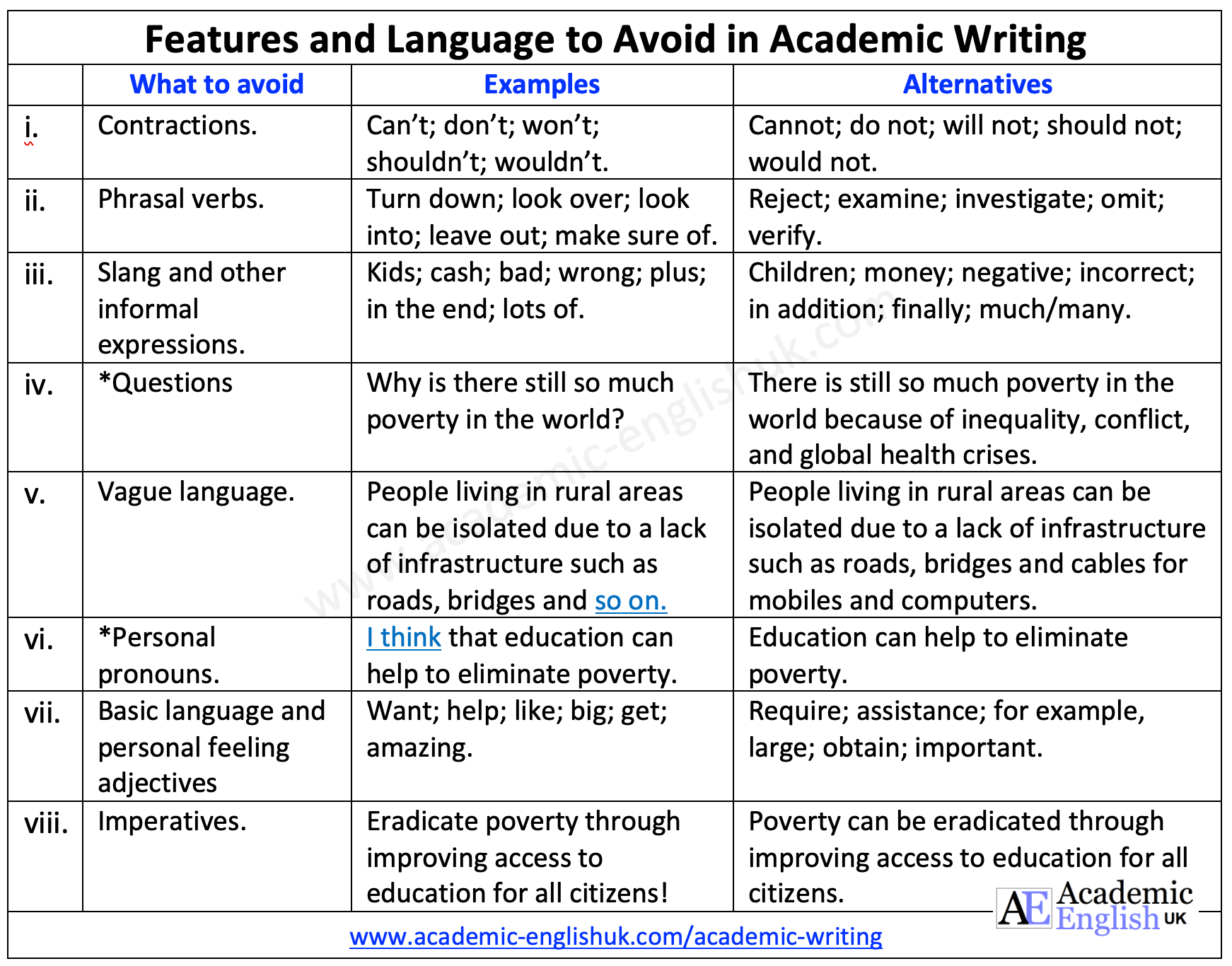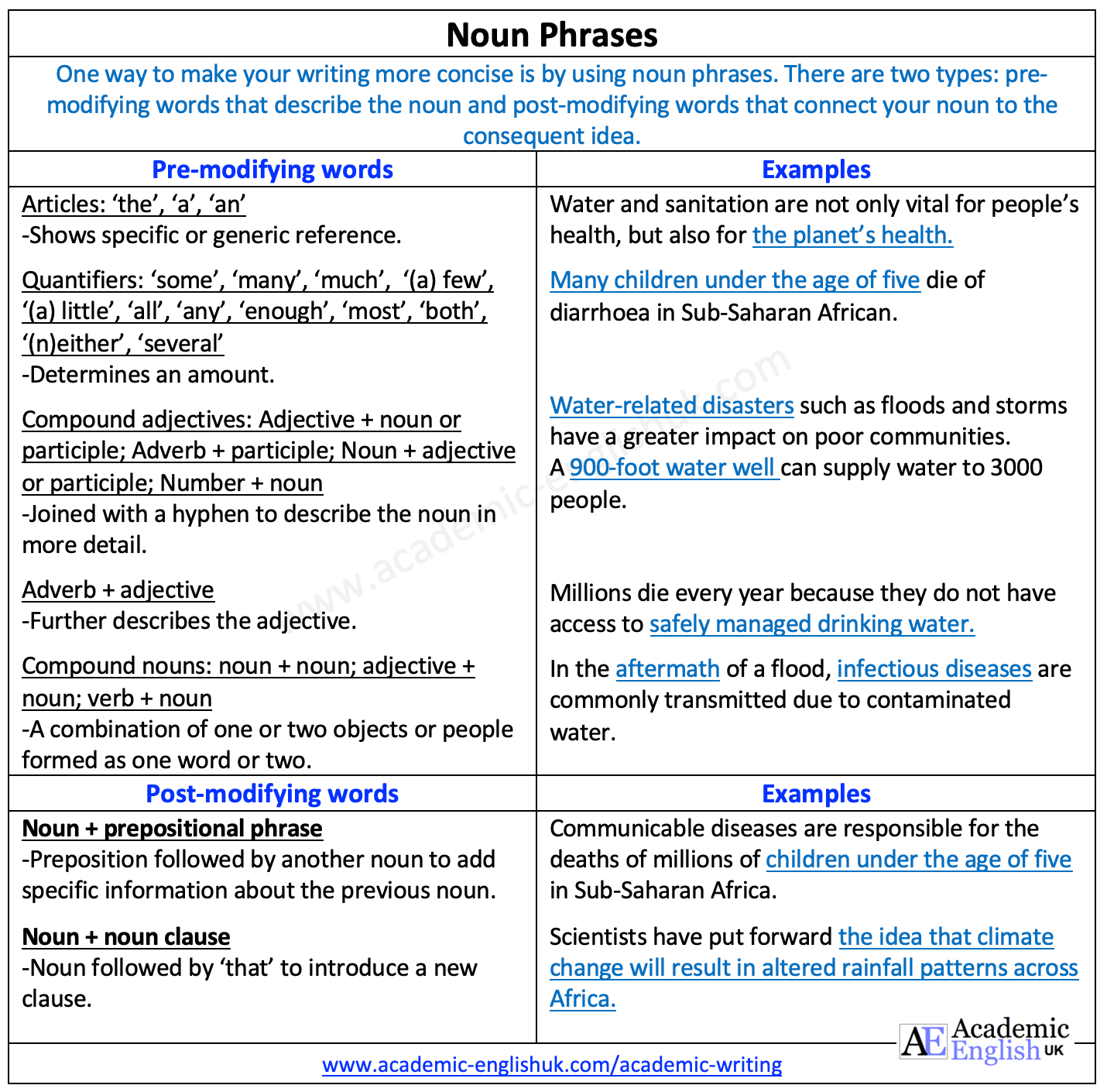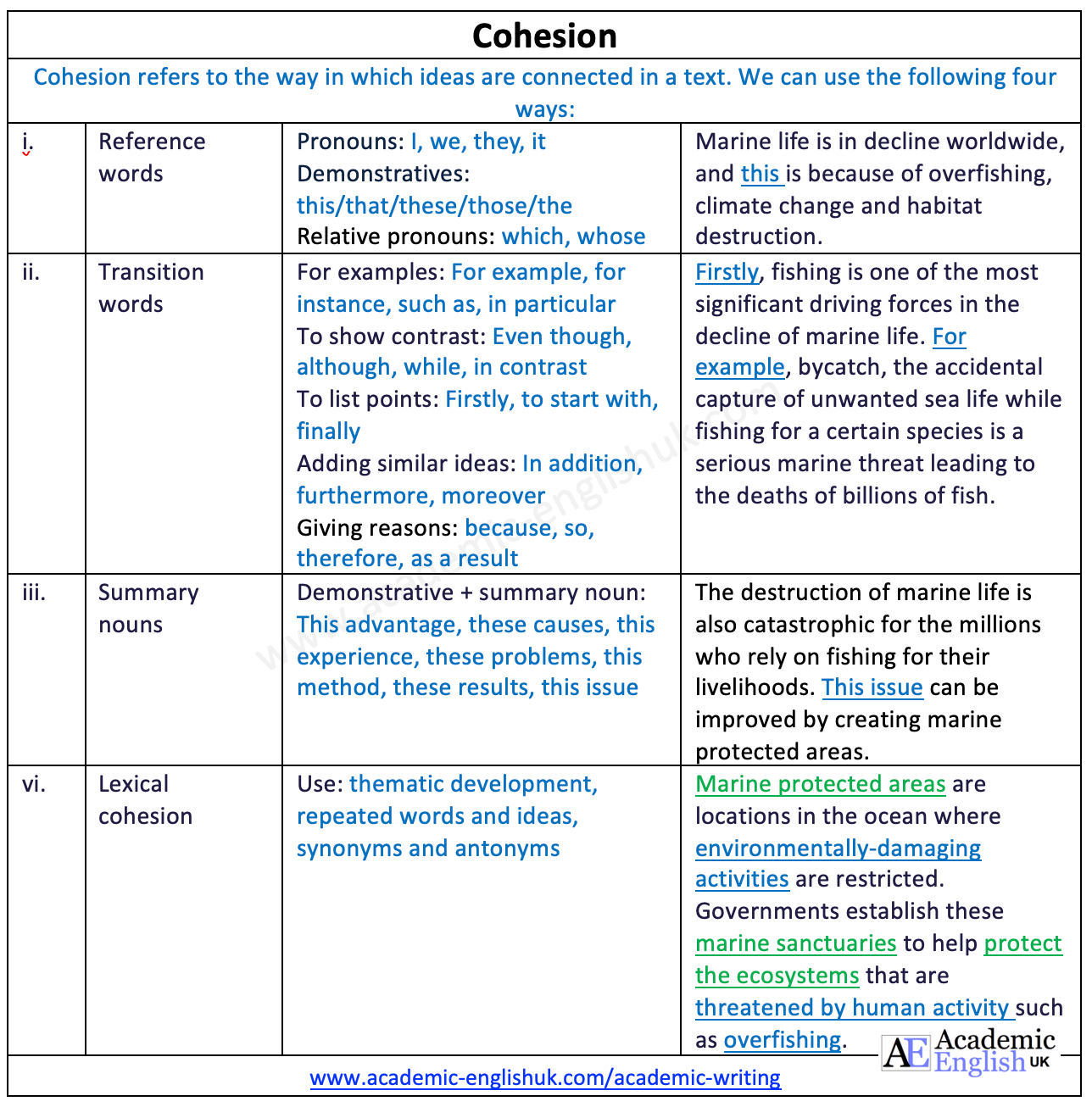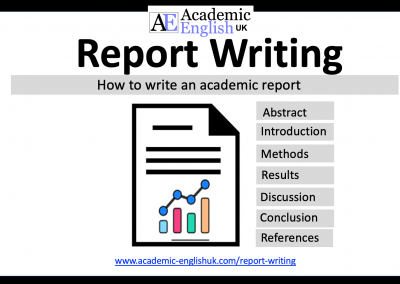The Top 10 Features of Academic Writing
An Introduction to Academic Writing
1. Who is it for? These lessons are designed for international students who are aiming to study in a university where English is the medium of instruction. No prior knowledge of academic writing is required, but the ability to read instructions will be helpful.
2. How long will it take to complete each lesson? Depending on the level of the student, their knowledge of academic English, and prior subject knowledge, each lesson would expect to take 60-90 minutes to complete. There are ten lessons altogether.
3. What is academic writing? Academic writing is a particular writing style that is seen in academic papers and students’ assignments. It includes certain textual and grammatical features; it contains a logical structure, and it involves using a more formal register than everyday communication.
4. What features of academic writing will this booklet cover
- Features and language to avoid.
- The passive voice.
- Hedging.
- Academic word list.
- Noun phrases.
- Complex sentence structure.
- Cause and effect.
- Parallelism.
- Coherence.
- Cohesion.
Note: It is impossible to cover all aspects of each feature within the constraints of this booklet, therefore we have selected what we think are the most helpful.
5. What context will be used to practice academic writing? The topic is ‘global issues’ and is connected to the United Nations Sustainable Development Goals (SDGs). These are 17 global goals that aim to create a better world for everyone by ending poverty and protecting the planet. Each lesson in the booklet contains the vocabulary from one or two SDGs; covering 1-15.
6. How to use these lessons. Students can use this independently or teachers can use it with their classes in either guided lessons or in a workshop type scenario.
- Step 1: Look at the link at the beginning of each lesson for context.
- Step 2: Look up the vocabulary in the ‘vocabulary box’ before completing the tasks.
- Step 3: Read about the features of academic writing for that lesson (Task 1).
- Step 4: Work through each task reading the instructions carefully and checking the answers after each exercise by clicking on the links provided.
- Step 5: Start applying what you have learnt to your academic assignments.
Academic Writing Downloads
Click on any link to be taken to the download
An Introduction to Academic Writing.
The top 10 features of academic writing
If you can’t access this YouTube video in your country, go here
Video Worksheet: click here
Booklet Download
Academic Writing Workbook: 10x lessons
Academic Writing Workbook: 10x lessons (new 2024)
This academic writing workbook will enable students to improve their writing skills by introducing them to ten important areas of good academic writing style. Each area includes instructions, rules with examples, plenty of practice activities within the context of the UN SDGs and an answer key. The 10 areas are: 1) Academic style. 2) Passive grammar. 3) Hedging. 4) AWL. 5) Noun phrases. 6) Complex sentence structure. 7) Cause & effect. 8) Parallelism. 9) Coherence. 10) Cohesion. Example. Level: ***** [B1/B2/C1] TEACHER MEMBERSHIP / INSTITUTIONAL MEMBERSHIP
*
Individual Lesson Downloads
1. Features and Language to Avoid in Academic Writing
Features and Language to Avoid in Academic Writing Worksheet 1 (new 2024)
This worksheet introduces students to the features and language to avoid when writing in an academic style. It includes instructions, rules, plenty of practice activities within the context of the UN SDGs and an answer key. This worksheet can be used on its own or as part of our academic writing booklet and is suitable for classroom use or self-study. Example. Level: ***** [B1/B2/C1] TEACHER MEMBERSHIP / INSTITUTIONAL MEMBERSHIP
*
2. Passive Grammar
Academic Writing: Passive Grammar Worksheet 2 (new 2024)
This worksheet introduces students to the passive voice. It includes instructions, rules, plenty of practice activities within the context of the UN SDGs and an answer key. This worksheet can be used on its own or as part of our academic writing booklet and is suitable for classroom use or self-study. Example. Level: ***** [B1/B2/C1] TEACHER MEMBERSHIP / INSTITUTIONAL MEMBERSHIP
*
3. Hedging / Cautious Language
Academic Writing: Hedging / Cautious Language Worksheet 3 (new 2024)
This worksheet introduces students to hedging. It includes instructions, rules, plenty of practice activities within the context of the UN SDGs and an answer key. This worksheet can be used on its own or as part of our academic writing booklet and is suitable for classroom use or self-study. Example. Level: ***** [B1/B2/C1] TEACHER MEMBERSHIP / INSTITUTIONAL MEMBERSHIP
*
4. Academic Word List (AWL)
Academic Writing: The Academic Word List (AWL) Worksheet 4 (new 2024)
This worksheet introduces students to the academic wordlist (AWL). It includes instructions, rules, plenty of practice activities within the context of the UN SDGs and an answer key. This worksheet can be used on its own or as part of our academic writing booklet and is suitable for classroom use or self-study. Example. Level: ***** [B1/B2/C1] TEACHER MEMBERSHIP / INSTITUTIONAL MEMBERSHIP
*
5. Noun Phrases
Academic Writing: Noun Phrases Worksheet 5 (new 2024)
This worksheet introduces students to noun phrases. It includes instructions, rules, plenty of practice activities within the context of the UN SDGs and an answer key. This worksheet can be used on its own or as part of our academic writing booklet and is suitable for classroom use or self-study. Example. Level: ***** [B1/B2/C1] TEACHER MEMBERSHIP / INSTITUTIONAL MEMBERSHIP
*
6. Complex Sentence Structure
Academic Writing: Complex Sentence Structure Worksheet 6 (new 2024)
This worksheet introduces students to complex sentence structure. It includes instructions, rules, plenty of practice activities within the context of the UN SDGs and an answer key. This worksheet can be used on its own or as part of our academic writing booklet and is suitable for classroom use or self-study. Example. Level: ***** [B1/B2/C1] TEACHER MEMBERSHIP / INSTITUTIONAL MEMBERSHIP
*
7. Cause and Effect
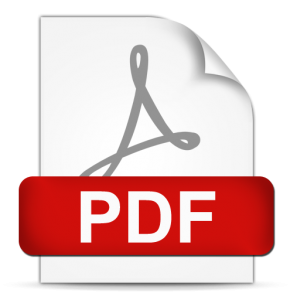 Academic Writing: Cause and Effect Worksheet 7 (new 2024)
Academic Writing: Cause and Effect Worksheet 7 (new 2024)
This worksheet introduces students to the language of cause and effect. It includes instructions, rules, plenty of practice activities within the context of the UN SDGs and an answer key. This worksheet can be used on its own or as part of our academic writing booklet and is suitable for classroom use or self-study. Example. Level: ***** [B1/B2/C1] TEACHER MEMBERSHIP / INSTITUTIONAL MEMBERSHIP
*
8. Parallelism
Academic Writing: Parallelism Worksheet 8 (new 2024)
This worksheet introduces students to parallelism. It includes instructions, rules, plenty of practice activities within the context of the UN SDGs and an answer key. This worksheet can be used on its own or as part of our academic writing booklet and is suitable for classroom use or self-study. Example. Level: ***** [B1/B2/C1] TEACHER MEMBERSHIP / INSTITUTIONAL MEMBERSHIP
*
9. Coherence
Academic Writing: Coherence Worksheet 9 (new 2024)
This worksheet introduces students to coherence. It includes instructions, rules, plenty of practice activities within the context of the UN SDGs and an answer key. This worksheet can be used on its own or as part of our academic writing booklet and is suitable for classroom use or self-study. Example. Level: ***** [B1/B2/C1] TEACHER MEMBERSHIP / INSTITUTIONAL MEMBERSHIP
*
10. Cohesion
Academic Writing: Cohesion Worksheet 10 (new 2024)
This worksheet introduces students to cohesion. It includes teacher’s notes, rules, plenty of practice activities within the context of the UN SDGs and an answer key. This worksheet can be used on its own or as part of our academic writing booklet and is suitable for classroom use or self-study. Example. Level: ***** [B1/B2/C1] TEACHER MEMBERSHIP / INSTITUTIONAL MEMBERSHIP
*
Academic Writing Workbook: 10x lessons
Academic Writing Workbook: 10x lessons (new 2024)
This academic writing workbook will enable students to improve their writing skills by introducing them to ten important areas of good academic writing style. Each area includes instructions, rules with examples, plenty of practice activities within the context of the UN SDGs and an answer key. The 10 areas are: 1) Academic style. 2) Passive grammar. 3) Hedging. 4) AWL. 5) Noun phrases. 6) Complex sentence structure. 7) Cause & effect. 8) Parallelism. 9) Coherence. 10) Cohesion. Example. Level: ***** [B1/B2/C1] TEACHER MEMBERSHIP / INSTITUTIONAL MEMBERSHIP
*


